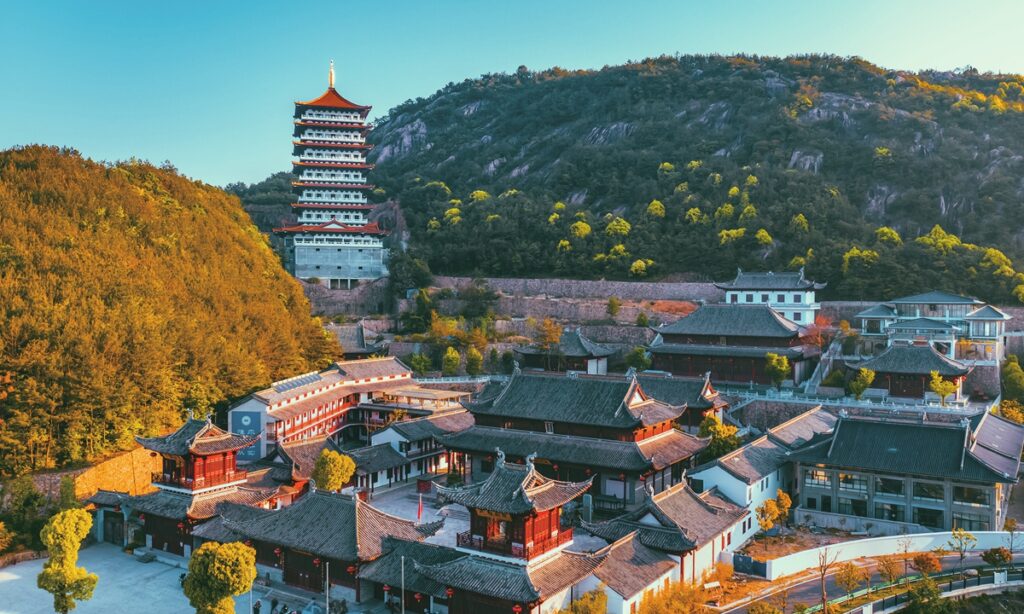Exploring Tiantai Mountain, Hehe culture’s hometown
“We advocate harmony and inclusiveness, and promote exchanges and mutual learning among civilizations…” Six young individuals, representing different countries, ethnicities and cultures, echoed the Hehe World Initiative during the recently concluded 2023 Global Forum on Hehe Culture.
Experts at the event told the Global Times that Hehe culture embodies the idea of the harmonious coexistence of man and nature.
It recognizes the conditions and space for the development of all entities, respecting the collective progress of nations and ethnicities for the common well-being of humanity.
The first “he” in Hehe means harmony, peace, and balance, while the second “he” means convergence, unity, and cooperation.
In the long history of Chinese Hehe culture, Tiantai county in Taizhou, East China’s Zhejiang Province, stands out as a vital hub.
The essence of Hehe culture emerged 1,300 years ago on Tiantai Mountain, embracing the concept of unity among Confucianism, Buddhism, and Taoism.
Although the Hehe culture is a concept proposed in the late 1980s and early 1990s, ancient Chinese’s wisdom about harmony has existed since ancient China.
The two words of “he” have appeared separately in oracle bone inscriptions and bronze inscriptions.
The first systematic theoretical exposition of Hehe culture was realized by Shi Bo, a thinker during the Western Zhou Dynasty (1046BC-771BC).
Based on the theory of the harmony of the five elements, he defined the concept of Hehe, thus he can be regarded as the founder of Chinese Hehe culture.
Tiantai Buddhism
To truly grasp the essence of Hehe culture, one cannot overlook the Guoqing Temple, one of the birthplaces of Tiantai Buddhism, an East Asian Buddhist school of Mahayana Buddhism that developed in the 6th century in China.
Situated in Tiantai county, Guoqing Temple was built during the Sui Dynasty (581-618), and it played a crucial role in the transmission of Chinese Tiantai Buddhism, emphasizing the dual cultivation of contemplating and illuminating the mind to perceive nature.
When walking to the Guoqing Temple, one can see the temple was surrounded by mountains and hundred-year-old ancient trees.
There were small bridges and a flowing river surrounding the temple, which gave visitors a sense of calm.
Stepping on the cobblestone floor with a historical texture and entering the temple, some pilgrims kneel down devoutly with their hands clasped together.
A sweet fragrance lingers in the incense burner.
Along with the melodious bells and low chanting sounds coming from the main hall, all fatigue disappears immediately.
Amid the golden autumn, the rice that was donated by the locals as respect to the monks in the temple is basking in the temple yard.
One of the managers working in the temple told the Global Times that every year (except during the pandemic), numerous tourists from both China and abroad, especially from South Korea and Japan, visit the Guoqing Temple.
He explained that since the Tang (618-907) and Song dynasties (960 – 1279), the temple has been revered as the ancestral home of Tiantai Buddhism for both Japanese and Korean practitioners.
Adhering to the “harmonious coexistence” philosophy, this 4A-level scenic spot remains open to the public for free.
At the foot of the temple, the sight of farmers diligently cultivating fields amid the surrounding mountains and streams exemplifies a harmonious coexistence between man and nature.
In a world marked by continuous conflicts and contradictions, as well as a time of fusion and exchange, being in this environment allows people to have a deeper understanding of the value of “harmony.”
Inheritance of Hehe spirit
“Hehe Erxian,” the charming duo of two Chinese immortals, one holding a food container and the other carrying lotus flowers, symbolizes the pursuit of a spirit that harmonizes the body and mind, interpersonal relationships, and the connection between heaven and humanity.
These legendary figures – Hanshan and Shide – have become the epitome of Chinese “harmony culture,” conveying a unique spirit.
Hanshan, a poet who resided on Tiantai Mountain in Tang Dynasty (618-907), left a legacy of around 600 poems, emphasizing the unique realm of harmonizing the body and mind, the unity of heaven and humanity, and interpersonal harmony.
This distinctive realm, translated by American poet Gary Snyder, profoundly influenced the “Beat Generation” in the US.
The influence of “Hehe Erxian” in folk culture is evident in a cultural park themed on the “Hehe” concept in Tiantai county.
One folk museum in the cultural park houses thousands of artifacts related to the two immortals including cultural and artistic items, crafts, rare collections, and historical materials, showcasing the omnipresence of the harmony culture in Tiantai’s traditions.
In an art museum showcasing “Yigenteng,” an intangible cultural heritage craft with a history of 400 years, the intricate intertwining and connecting of vine-shaped structures symbolizes people’s pursuit of enduring happiness and complete harmony.
This cultural park, mainly transformed from old factories, has gathered over 3,000 items related to harmony culture and historical materials. The park attracts approximately 80,000 visitors each year.
It has evolved into a comprehensive cultural industry park incorporating wedding celebrations, educational tours, and cultural innovation.
The park shows that the spirit of harmony, while rooted in tradition, has been endowed with modern values.
The beauty of harmony is now visibly integrated into the urban development of Taizhou, where landmarks of harmony connect with the city’s cultural temperament.
The coexistence of people and the city, which embodies the spirit of “harmony,” has truly become the urban ethos of Taizhou.
(Global Times)




